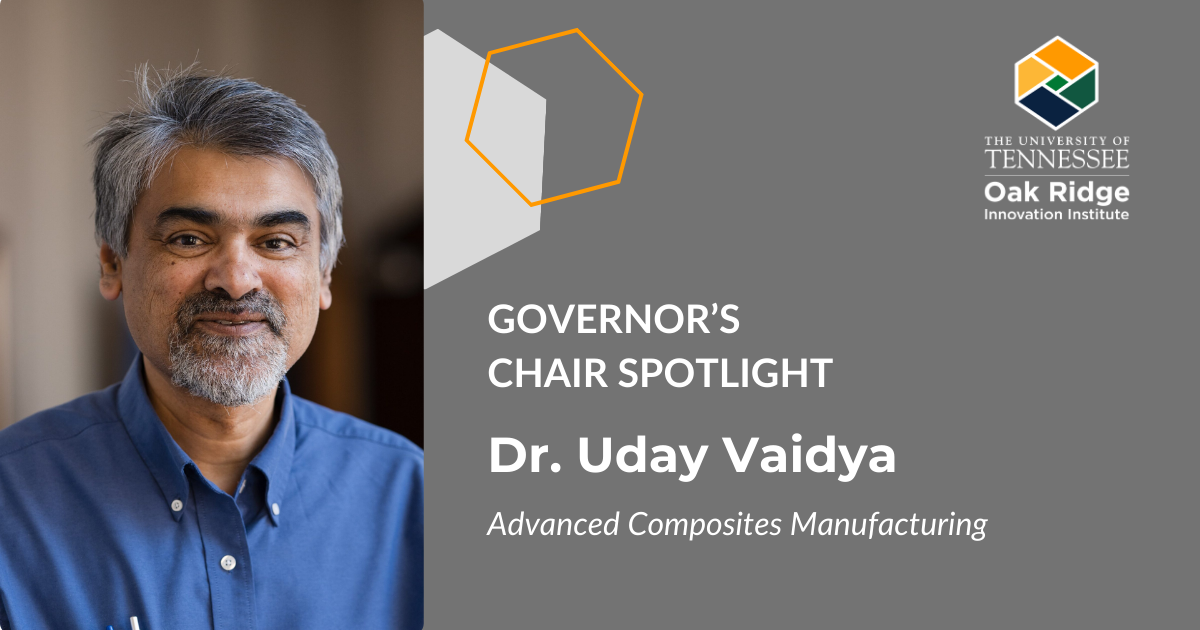Uday Vaidya, the University of Tennessee-Oak Ridge National Laboratory Governor’s Chair in Advanced Composites Manufacturing, is getting students excited about STEM and is a driving force in making the university a major player in the field of composites.
Vaidya’s interest in composite materials was sparked during college when he worked on a project related to tap testing of a glass composite aircraft wing to find embedded defects.
Tap testing is a method of inspection. A bright, metallic sound indicates good structure; a dull “thud” indicates there may be a flaw.
In the 30-plus years since then, Vaidya has become an expert on designing, manufacturing and testing advanced materials that are lightweight, energy-efficient, low-cost, able to withstand extreme environments, and recyclable. His work has applications for automotive, mass transit, aerospace, infrastructure, marine, sporting and healthcare industries.
In 2015, Vaidya was named a distinguished UT-ORNL Governor’s Chair, a program led by the UT-Oak Ridge Innovation Institute. Since joining UT-ORNL as the Governor’s Chair in Advanced Composites Manufacturing, Vaidya has become a driving force in making the university a major player in the field of composites. Composite materials are formed by combining two or more materials that have unique properties.
UT Chancellor Donde Plowman has referred to Vaidya as “one of our most prolific inventors.”
A faculty member in the Tickle College of Engineering’s Department of Mechanical, Aerospace and Biomedical Engineering, Vaidya is the director of the Fibers and Composites Manufacturing Facility (FCMF). He has been the chief technology officer of the Institute for Advanced Composites and Manufacturing Innovation (IACMI) since its founding in 2015.
Vaidya saw one of his visions begin to take shape in June 2023 when ground was broken on Innovation South, an 85,000-square-foot multi-use facility at the UT Research Park at Cherokee Farm. The facility will be the new, expanded home of the FCMF.
“This facility will be amazing for learners at all levels because they will get hands-on experience with everything the industry needs them to know,” Vaidya said. “We are projecting at least 50 graduate students and about 100 undergraduates in each semester will work on research projects, plus about 10 postdocs and technical staff. Add to that mix 50 to 100 students and workers coming through for training each year. It will be a very dynamic space.
“If you look at the automotive sector today, there is glass, carbon, and basalt fibers, and a range of different resin types that each require a process flow,” he said. “The Innovative South facility will enable us to develop ‘materials-by-design’ solutions that will save cost, energy and manufacturing time of next-generation products.”
During the pandemic, Vaidya led a team of researchers who used their expertise to design molds and mass-produce face shields for healthcare workers and the community.
“Our team of internationally recognized academic and business leaders, scientists, and students have the flexibility, as well as the full support of forward-thinking leadership to remove typical barriers and catalyze the rapid innovation that will help millions of people,” he said at the time.
Vaidya has a bachelor’s degree in mechanical engineering from Karnataka University in India, a master’s degree in mechanical design engineering from Shivaji University in India, and a doctorate in mechanical engineering from Auburn University.
Before coming to UT, Vaidya was on the faculty at the University of Alabama at Birmingham, North Dakota State University and Tuskegee University.
He is a fellow of the Society for Advanced Materials and Process Engineering (SAMPE) and the Society for Plastics Engineers (SPE). His honors include being named the 2016 SPE Composites Division’s Composites Person of the Year. He serves as the editor-in-chief of a leading Elsevier journal, Composites Part B : Engineering.
Vaidya is interested in engaging minority and underrepresented students in STEM fields and advanced manufacturing technologies. He and his team have introduced major initiatives for K-12 via on-site visits, demonstrations, workshops and instructional kits. More than 2,000 students have benefited from his initiatives since October 2022.
When he’s not working, Vaidya enjoys graphics design, arts and crafts, and writing educational books and content for short films.




